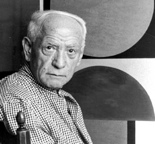
Herbin is one of the most highly regarded European artists of the twentieth century. Born in a small village near the Belgian border, he attended the Ecole des Beaux Arts in Lille in 1900. In 1903 he went to live in Paris where he became involved with the Impressionists and later the Fauves, and exhibited at the Salon des Independents in 1906. In 1909 he took a studio in the famous Bateau-Lavoir building, which was at the centre of Cubism. His studio was next to Braque's and Picasso's and Herbin became a prominent exponent of the movement, and participated in the activities of the legendary Section d’Or group. He also exhibited with the Der Sturm group in Berlin. From 1912 his work became increasingly abstracted, and along with Gleizes, Valmier and Delaunay, was one of the first French painters to adopt pure abstraction. In 1913 he exhibited in the historic Armory Show in New York. He was then taken on by Léonce Rosenberg at his influential gallery “L’Effort Moderne”, where he joined Metzinger and Valmier, and held several solo shows.
In the aftermath of the First World War abstraction was universally abandoned, as it was considered too subversive at a time when society required stabilisation. Herbin returned to a stylized figuration and it was during this period of the early 1920’s that the present work was painted. At first glance the composition appears to be a conventional still life, but further consideration soon makes us aware of the hyper real intensity of the colours, and Herbin has also subtly incorporated several Cubist tricks of perspective, most obviously in the rim of the bowl, in what may have been considered by some at the time to be an almost heretical concession to his avant-garde inclination.
In 1926 Herbin returned to Abstraction, and in 1931 founded the Abstraction Création group with Vantongerloo that would unite the abstract cause across Europe. In 1946 he was a co-founder of the Salon des Réalités Nouvelles which was dedicated to the promotion of abstraction. Herbin developed a complex theory of colour and form from which he produced his “Alphabet Plastique” as described in detail in his 1949 book “L’Art Non Figuratif Non Objectif”, and the rest of his career was dedicated to its refinement.
Throughout his career Herbin exhibited extensively in both museums and galleries, and since his death in 1960 his work continues to be celebrated in exhibitions around the world.
The artist’s work is represented in numerous museums worldwide including: Musée Nationale d'Art Moderne de Paris; Tate Modern, London; Kroller Muller Museum, Otterlo; Hermitage Museum, St Petersburg; Museum of Modern Art, Stockholm; Kunsthaus, Zurich; State Museum, Cologne; Museum of Modern Art, Oslo; Museum of Contemprary Art, Caracas; Guggenheim Museum, New York; Museum of Modern Art, New York.